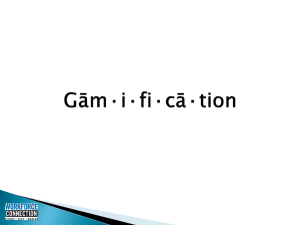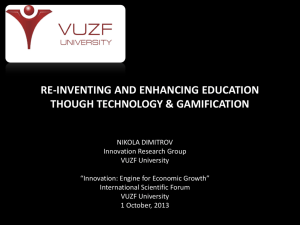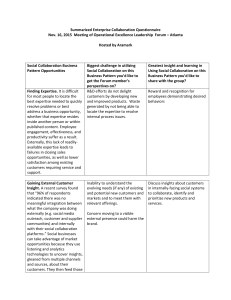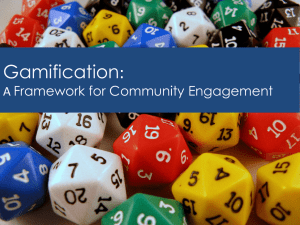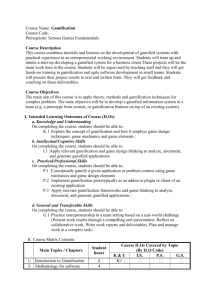Leveling Up Capstone Courtney Sant
advertisement
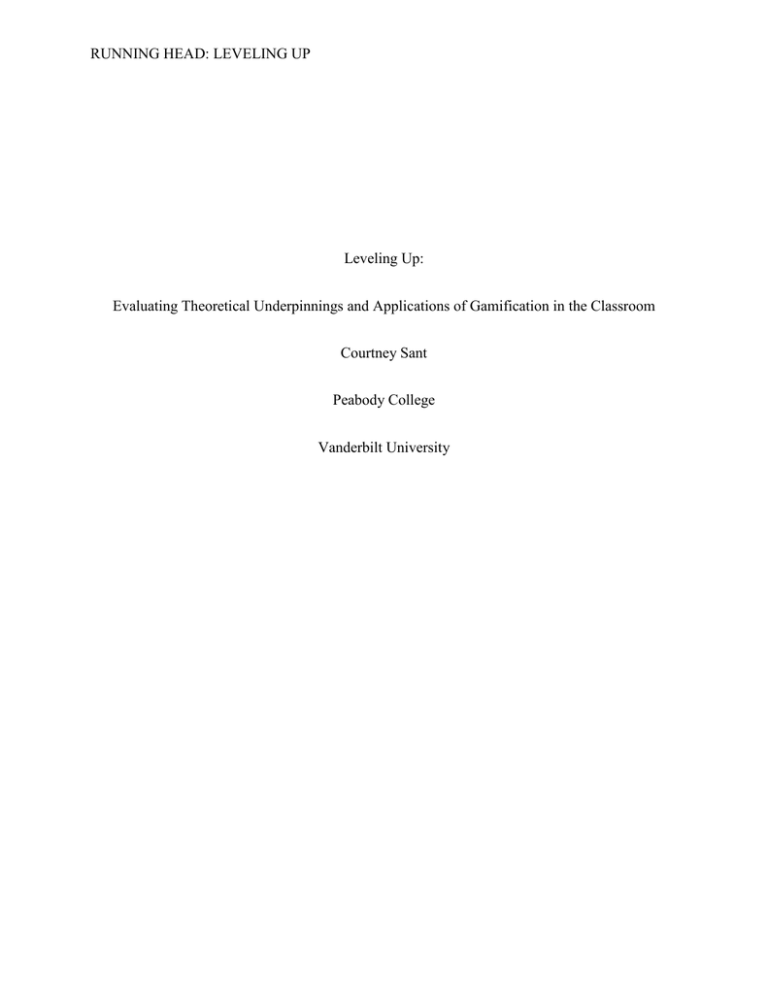
RUNNING HEAD: LEVELING UP Leveling Up: Evaluating Theoretical Underpinnings and Applications of Gamification in the Classroom Courtney Sant Peabody College Vanderbilt University LEVELING UP 2 Abstract “Gamification” has become quite the buzz word in the last few years. After all, children love games so why not use that advantage in the classroom? But there seems to be a great deal of confusion as to what gamification actually is and how it can be implemented in the classroom. Through judicious literary review, arguments will assert a strong case for gamification having robust theoretical underpinnings that can be used to inform teaching practices. This capstone will delve into the importance of informed choices concerning physical spaces and of the use of intelligent tools to promote learning. Also, gamification’s assertion that learning should be done in “communities of participation” with students have the right to make meaningful choices that affects not only how they learn but also how they demonstrate that learning, will be explored. These gamification principles are clarified by showing how skilled game developers have used them within the gaming environment and, by investigating these examples, connections are made for how these principles can be utilized within the educational context: like incorporating project-based learning. Finally, these gamification principles will then be contrasted with some of the limited ways that gamification has been incorporated within the school. Through illuminating the disparities, future implementations will be explored about how academia could gain a more developed understanding of gamification. LEVELING UP 3 Why discuss Gamification? “More and more, we recognize the unrivaled power of gameplay to create common ground, to concentrate our collective attention, and to inspire long-term efforts… If we commit to harnessing the power of games for real happiness and real change, then a better reality is more than possible - it is likely.” (McGonigal, 2011) When beginning any discussion about gamification it is important to discuss what gamification is not. This capstone is not going to make a case for using video games in the classroom, or even touching on the place of games in the learning environment. This capstone is also not about turning the classroom into one giant game; though, as will be discussed later on, some practitioners have used the term “gamification” to describe just that. It is this lack of general understanding of what gamification means that makes it so hard to have a serious discussion about it. The main problem behind this is many have not been told that gamification is about principles that can be applied universally to situations containing human interaction (McGonigal, 2011) and as such it is grounded in, and supports, modern learning theories and research. That is what this capstone was all about: making the case that gamification is a legitimate educational theory that should be taken and applied, just as seriously as any other. Gamification is about taking an in-depth look at the underlying principles of what makes games such engaging experiences and then applies these principles to other contexts (Gee, 2003). And, to combat another misconception, gamification isn’t just about motivation. This capstone maintains that the principles of gamification have profound influences on all aspects of education: from organizing the environment to crafting curriculum and on through assessment. But what gamification has to say about all these aspects is nothing new. It will become very clear to anyone in the educational field that gamification has a solid foundation in well-known and LEVELING UP 4 accepted learning theories and research. But gamification “provides another layer and a new way of weaving together those elements (learning theories) into an engaging space that both motivates and educates learners” (Kapp, 2012, p. 12). Since there are many principles within gamification, too many to explore all of them within this capstone, only a few principles that have a profound impact on the classroom environment will be expanded upon. How does gamification help set up a learning environment? As with all learning practices, gamification is not context dependent: just as it can incorporate any learner, gamification can be used within any context. Gamification can be used at any grade level, in any environment: both inside and outside school (Kapp, 2012). That being said this capstone is going to be focusing on how gamification can transform the classroom space inside schools. UNIFIED ENVIRONMENTS The first principle of gamification within an environment is that everything within the learning environment, from physical objects to encouraged behavior, is consistent and all focused on the same goals (Gee, 2003). This means making sure the classroom decorations and layout are in harmony with the tools being used, all of which work with the curriculum to create a cohesive whole that speaks to the class’ purpose. This is not a new concept; it is one of the main arguments used in the sociocultural perspective. Since it is argued that the nature of learning is “inherently context-dependent, situated, and enculturating,” (Brown, Collins, & Duguid, 1989, p. 39) then the environment itself affects what and how concepts are being learned. So a situativist would agree that the environment should be set up in such a way that LEVELING UP 5 supports learning goals. Constructionist would also agree that this is a good idea. While maybe not as stressed, constructionist would argue that because learning is about creating connections between oneself and the knowledge being taught (Duffy & Cunningham, 1996) then this process might be helped along if the actual physical world around the student is helping them make connections to the learning goals. But where gamification is different, is the amount of effort and thoughtfulness that is put in to make sure of this consistency. To illustrate this difference all one needs to do is look at game developers. Game developers can spend years making sure that everything “fits” together (Squire, 2011). Game developers must make every major aspect of the game, from art style to color palette, and music, as well as game mechanics, all work. An example of the cohesion of all elements can be seen in a little game called Paper, Please. In Paper, Please the goal is to thrust players into a distopic, communist nation during the cold war and feel the heartache of trying to survive. It is trying to get across how oppressive, depressing, and repressive living under such a government is and every aspect of the game delivers on this message. The music is simple and forceful; the game mechanics are hard; players have a high chance of failure and death; and the game is colored in mostly black, red, brown, and grey. The art style is blocky and made to appear as though it was made in the 1980’s, which is in concord with the setting of the plot which is supposed to take place in 1983 (“Papers, Please”, n.d.). The utmost care went into this unity of elements and it is one of the reasons Papers, Please is considered a very compelling, if not depressing, game. Imagine if teachers put this much effort into the consistence of their environment. Teachers would have to not only think carefully about the arrangement of their seats and tools available for student use but also what this says about their class and the appropriate behavior therein. Also, great consideration would need to be taken for how LEVELING UP 6 classroom decorations could illustrate and enhance the learning goals of the classroom. Does the physical environment work in tangent tandem with the curriculum to achieve learning objectives? In gamification these are all critical concerns that cannot be understated or overlooked. DISTRIBUTE KNOWLEDGE Within the environment it is also imperative to distribute knowledge and meaning between “learner, objects, tools, symbols, technologies, and the environment” (Gee, 2003, p. 227). Situative theorists maintain that learning is a joint accomplishment between learner and the environment (Lave & Wenger, 1991) so gamification is just emphasizing that one should be allowed to take advantage of the knowledge inherent in one’s surroundings. After all many tools just help stop “bottlenecks of complex mentation reside” (Pea, 1993, p. 82) since tools cannot engage in higher order thinking skills like analyzing, judging, and interpreting. This will leave the learner with more time to concentrate on more complex and deeper understandings. An excellent example of knowledge being utilized within tools to create deeper understandings is the evolution of game mechanics and encounters in World of Warcraft. World of Warcraft, commonly known as WoW, is an online game where people from around the world work together to accomplish in-game goals. WoW was released in 2004 and became massively popular (“World of Warcraft, n.d.). Soon, fan-made websites began popping up on the internet to help fellow players. First among them was Thottbot and then Wowhead was used as databases for everything the players could interact with, and every mechanics in the game. As the websites got more sophisticated, players soon knew what every boss (hard enemies that players had to work together to defeat to get big rewards) did and strategies that could be used to defeat them. LEVELING UP 7 Once YouTube got popular, videos were even made that showed players the whole encounter, from beginning to the boss’ defeat. Over time it became expected within the player community that everyone research bosses and watch the videos before they tried to beat them within the game. The developers realized this and adapted accordingly. Instead of trying to stop players from receiving this knowledge on the internet the developers made more elaborate boss battles. In earlier boss battles players just had to worry about basic game mechanics and very little besides themselves. But as time went on boss battles began focusing on more abstract skills, since it was assumed players would already look up and know basic mechanics; like teamwork, spacial awareness and reasoning, and metaknowledge of the game. The amount of learning and mastery of skills that must go into defeating these ever-evolving boss battles are immense and only obtainable with the assumption that players will use online resources to obtain basic information. Contrast the responses between the developers of WoW to their situation with many math teachers in regards to calculators. When WoW was first released WoW developers made their game with certain assumptions. Then it became clear that players were making tools that made the basic game mechanics more transparent which rendered the game much easier than expected. Instead of trying to remove these tools WoW developers embraced them and used these tools to increase the game’s depth by emphasizing more elements that could not be categorized online, like critical thinking skills, team work, and adaptability. There are many math teachers, even in upper level math classes, who have the complete opposite response: they take away calculators from their students and make them do all calculations by hand. So, instead of letting the calculators do the basic calculations and delving deeper into mathematical concepts and utilities, teachers are artificially handicapping their students so that the difficulty level of their class will LEVELING UP 8 not be changed. This emphasizes “individual, tool-free cognition” instead of “novel uses of resources for creative and intelligent activities” (Pea, 1993, p. 81). While the argument surrounding this controversy is more nuanced than what is given here; gamification is very clear: if teachers are taking away knowledge-embedded materials from within the learning environment there needs to be a very compelling reason for it and it should not be permanent. These tools should instead be utilized to help create richer learning environments. COMMUNITIES OF PARTICIPATION Learning environments are not all about the physical space but also encompass the classroom community. After all, in the example above, WoW players would not even have had access to the database tool unless there was a community of players willing and encouraged to make such tools for the use of all. That is one of the reasons why gamification stresses the importance of encouraging communities of participation. These communities need to be open to all and, more importantly, “include mechanisms for ‘ordinary users’ to contribute and moderate content” (Squire, p. 64). These communities, with light guidance from the teacher, should have the ability to self-organize with the license to “seek out, leverage, and even create communities to further their interests” (Squire, p. 75). As such, the community should have a great deal of depth with many paths toward becoming an “authentic participant” (Squire, p. 65). It is within these communities that individuals learn collectively and are more motivated to participate in various activities (Gee, 2003). Situative theorists use a different name, community of practice, but the idea is exactly the same. Learning is done through interactions between members of a community so participation is key to the learning model. Time is first spent with newcomers establishing and learning member’s expectations and move from peripheral participation to interacting with others within the center of the community (Lave & Wenger, 1991). Whether it LEVELING UP 9 be through cognitive apprenticeship or interacting within a community of learners, it is the participation of individuals that promotes learning and gamification recognizes it as such. An environment where community participation is key can be found in the game Minecraft. Minecraft is a very popular game, especially with older children and teenagers. One of the reasons for its huge success is that players have the ability to “mod” the game: that mean players have the ability to put their own computer code into the game and change the way Minecraft is played. This has made the game itself incredibly participatory as players themselves have the ability to modify games anyway they like and set it up for people to play in. This turns players from consumers into producers. Not only that, but it is well known in the gaming world that popular games cultivate an “affinity group” around them (Gee, 2003). There are websites out there ranging from discussing how to find rare materials to galleries of artwork made in game. There are blogs focusing on Minecraft and YouTube videos showing people playing the game. These are vastly different websites that cater to many different types of players but they all have one thing in common: they are all run and moderated by fans. Fans make most of the content online and communities have sprouted up around them. As very little can be done alone; everyone, at the minimum, interacts with others as they play the game together. Along with going to different sites and reading articles, this is peripheral participation. But as time goes on, and as players engage more in the game, they might start commenting on sites and adding to the collective knowledge. This is when participants become producers. Players no longer just play the game but they author papers, become teachers to novices, produce art work, and even code the game to make a unique game play experience for those around them. This is what communities of participation is all about. Students actively engage with the material and use the knowledge they gain to fulfill other roles. But these sorts of environments LEVELING UP 10 can only come about if students have opportunities and are willing to become leaders, teachers, and producers (Gee, 2003). Students are both teacher and learner: it is the mix of those two roles that forward learning. EXPERTS AND NOVICES It is well known that teaching someone something helps one learn the concept better (Brown, Collins, & Duguid, 1989) and having access to multiple explanations for the same concept helps newer community members learn. Given the complex nature of the community there will also be fluidity as to when someone is an expert and when they are a novice. In the example above Minecraft has many ways to play and therefore there are many different aspects that one could be an expert or novice in. Some players are a knowledge expert: they might know all the different ways to combine materials and where to find said materials in game. Others might be experts in exploring while others still might be great at creating architectural masterpieces within their games. This doesn’t even touch upon skills players might be experts in outside of games: like computer coding, video editing, writing, and drawing. This is such a complex system of interactions no one person could be an expert in all aspects. But it is through the incorporation of all these areas of expertise that everyone in the community benefits. This kind of environment is one of the main thrusts of gamification: promoting a breathing, vibrant community where students are encouraged to play to their strengths and assist others in those areas while at the same time gaining new skills by learning from others. This allows the teacher to fill the roles of couch and advisor, not the primary “content dispenser” (Gee, 2003, p. 59). This is student centered learning at its finest with “multiple interest-driven trajectories, opportunities to learn with experts, paths toward becoming an authentic participant, LEVELING UP 11 and ways to lead the group itself” (Squire, 2011, p. 65). Supporting a community that possesses numerous opportunities to participate in various ways has huge repercussions on how one sets up one’s curriculum. How does gamification affect curriculum? CHOICE AND MULITIPLE ROUTES If one is to have a community of participation where everyone can use their skills to contribute to the collective knowledge it is very important that one’s curriculum is set up to support such interactions. Gamification stresses the importance of there being multiple ways to make progress so as to “allow learners to make choices, rely on their own strengths and style of learning, while also exploring alternative styles” (Squire, 2011, p. 46). This is also vital if one wants to have lots of different interactions happening within the classroom community. Both Minecraft and World of Warcraft thrive because there are lots of people with different expertise. Whether it be drawing, writing, editing, or commenting there are lots of choices for how to interact with the community. There are also many ways for players to succeed in both of these games. WoW alone has almost as many ways to play as there are players. Some players like to group together with lots of other players and defeat bosses; others like to learn how to craft better gear and items which they turn around the sell to other players. Still others like to spend their time collecting certain items: like trying to collect all the little pets you can find in the game. Then there are those who to write complex stories for their characters and role play with other people online. Modding in Minecraft makes that game just as varied. None of these activities are “wrong” and it is no surprise with so many activities open to them players are very engaged in both game. LEVELING UP 12 This is an incredibly powerful principle within gamification considering the effect of choice on the learning environment. Allowing students more choices has been proven to increase intrinsic motivation in students. Students that have some genuine choices about what they do or how they do it begin to “own” their problem (Larmer and Mergendoller, 2010) and this motivates students to be engaged throughout the learning process (Blumenfeld, Soloway, Marx, Krajcik, Guzdial, and Palincsar, 1991). INTRENSIC REWARDS AND ACHIEVEMENT When thinking on motivation within gamification most tend toward the extrinsic rewards games provide players: whether it is gaining points or just better items for their characters (McGonigal, 2011). While extrinsic rewards are a part of gameplay they are not the main source of motivation within games. Gee (2003) described his “Achievement Principle” for gamification as “learners of all levels of skill there are intrinsic rewards from the beginning, customized to each learner’s level, effort and signaling the learner’s ongoing achievements” (p. 223). It is key to note that Gee speaks of the intrinsic motivations games provide as extrinsic rewards have been shown to stunt students’ to self-direct their own learning later on (Duffy & Cunningham, 1996). Since gamification is about fostering students’ curiosity and getting them to work within groups participating in creating everyone’s collective knowledge giving lots of extrinsic rewards are counterproductive. So Gee links motivation to intrinsic rewards of achievement. Squire (2011) also links motivation to achievement. Squire goes further pointing out that games will often have short-, medium-, and long-range goals to insure that players are not only always achieving goals but always looking, knowing about and actively chasing larger goals (p. 7). LEVELING UP 13 Having overlapping goals is especially important for game developers who work on longer games. The Heroes of Might and Magic series is a perfect example of this in action. Games can last upwards of 5-7 hours with the main goal of conquering all enemies on the map. But within the game there were lots of “overlapping goals” (Squire, 2011) to achieve: short ones like buying all the men in town for the army or defeating a wandering monster, medium goals like upgrading a town or conquering an enemy town, and long-term goals like exploring the whole map or completely upgrading all the towns. Always being so close to achieving one’s goals gives players the well-known feeling of “just one more turn” that end up playing for hours more (McGonigal, 2011). Games are creating “achievement behavior” that can be used so effectively in schools. It has been shown that when students are put in a situation where they can demonstrate their competence, students find it enjoyable because it evokes their feelings of how much they value competence and increases their involvement with said task (Duffy & Cunningham, 1996). The motivation inherent in students when given the opportunity to demonstrate their abilities is one of the reasons project-based learning can be so powerful. PROJECT-BASED LEARNING IN CURRICULUM With such an emphasis on choice, participation, and student-driven learning; gamification supports project-based learning, PBL for short. PBL is all about students using critical thinking skills to work together to answer an open ended question about a topic that students themselves come up with. It is the student’s interactions with each other to solve problems that drive the learning. While the projects should be based around standards, they should also push beyond those standards (Blumenfeld, Soloway, Marx, Krajcik, Guzdial, and Palincsar, 1991). Projectbased curriculum is all about depth, not breadth. The projects also connect the subject matter to the students’ lives meaningfully. From technology to collaboration, students are also encouraged LEVELING UP 14 to build important skill sets to use in their everyday lives (Larmer and Mergendoller, 2010). This helps move the classroom past working just on academic concepts by helping students develop many important life skills. Gamification endorses all these aspects of PBL. What does gamification tell us about assessment? PROJECT-BASEDPROJECT-BASED LEARNING IN ASSESSMENT Gamification also agrees with PBL in its stance on assessment. One of the key distinctions of project-based learning is the publicly presented product constructed by students. This finished concrete product gives student an avenue to synthesize and evaluate everything they have learned. Also having tangible end results helps sustain interest (Duffy & Cunningham, 1996). To help foster this interest, end products must not just be posters and PowerPoints but should be something meaningful to students. Making podcasts, ads, inventing a device, or presenting in front of important people in the community are all ways that promote students to demonstrate mastery of the content (Blumenfeld et al., 1991). Overall students feel they have had a more engaging and enjoyable experience (Uden and Beaumont, 2006). Also in an environment endorsed by gamification the variety of end products helps more students express their expertise and help other students gain new skills. PBL places much value on student collaboration and various talents students bring to the classroom that can use to express their learning. Those good at writing can write, those good at drawing can draw, and computer skills like editing videos are encouraged. Students can work together to create physical objects. This is an environment where participation is key, where students are both experts and novices depending on what they are working on. Student choice is built fundamentally into the LEVELING UP 15 curriculum, and all of these aspects are valued through the assessment. Whether teachers engaged in PBL know it or not, they are engaged in the principles of gamification. TESTING FOR SKILLS Project-based learning is not the only means in which to gamify one’s classroom. While having assessments that involve making a physical object or impacting the world in noticeable ways is great, what is important in gamification is that it is one’s skills that are being tested not rote knowledge (Gee, 2003). This stresses the importance of functional or pragmatic ways of knowing. This promotes higher order thinking as it is not enough just to have declarative knowledge, but one must also use it appropriately as well. It needs to be pointed out that critical thinking is a skill, so “skill” is not limited to physical acts but instead being able to perform effectively with knowledge. Wiggins and McTighe (2011) call this understanding and as such the word understanding becomes a set of skills: being able to explain, interpret, apply and empathize (p. 84). Understanding is not static it “is the result of inference- the developing and testing of ideas by learners, with teacher assistance, as needed- culminating in an idea that seems useful and illustrative to the learner” (p. 14-15) As such, it is these skills that need to be tested and the assessments should reflect that. Testing skills instead of just facts can be seen in many games but a great example comes from the Legend of Zelda series. The Legend of Zelda series follows a very specific formula in every game. Each game is divided into dungeons, and each dungeon has a new weapon for the player to find and use. For example, players might find a bow or a boomerang in a dungeon. Once they find a new weapon they must use it to solve problems throughout the dungeon. For LEVELING UP 16 example, players can use the bow to hit down items that were too far to reach before. This gives players many different chances to critically think about their new item and how to use it. After many iterations of this, the player will come to a boss fight. The boss fight will always incorporate the new weapon into the battle in a very significant way. The fight also always forces players to use the weapon in a different way: this tests that the student can also think critically in the use of the new item and how to transfer what they know about it to a new situation. If a player has not mastered the new skills introduced in the dungeon then the player will be unable to defeat the boss and continue on with the game. The game takes it even further as the final battle of the entire game almost always has multiple stages that one must use different weapons and skill sets at each section. That means players are required to prove that they have mastered all the skills and have thought critically about each item in the game to finish it. This is the sort of assessment that Wiggins and McTighe (2011) would approve of. They advised teachers to “have learners practice judgment is using a few different skills, not just plugging in one skill on demand. Transfer is about judging which skill and knowledge to use when” (p. 114). Since transfer is the goal of school that is what teachers should be focusing and testing on: Can students transfer their new skills, including critical thinking, in new and profound ways? How is gamification being implemented in schools right now? BADGES When educators speak about gamification most of the time they are just talking about implementing some sort of badge system. From websites like Class Dojo (“Class Dojo”, 2014) these are simple systems where students can earn, or lose, points or badges. It is almost like people asked themselves “Children like games but why?” to which they answered themselves LEVELING UP 17 with “it must be all those extrinsic rewards they get like badges and levels”. What seems to not be understood is gamification is about taking the design theories behind games and incorporating them in a new context. Giving out badges is taking a game mechanic and using it in a new context; there is a huge difference between those two acts. Extrinsic rewards are used in games for motivational purposes but, as has been discussed, it is not the main source of motivation. Nor do game designers use extrinsic rewards to help teach players new skills or information. It is well known that extrinsic rewards can negatively impact future motivation for independent learning (Duffy & Cunningham, 1996). This is why one must be careful when giving extrinsic rewards and why this capstone focuses on the importance of cultivating intrinsic rewards. So while these could be useful tools in some situations these systems are “shallow” (Squire, 2011) gamification and one hopes that in the future the educational field can delve deeper than this. Another attempt at gamification with a little more depth is called Classcraft. But as with the implementing a badge system, Classcraft suffers from confusing gamification with incorporating game mechanics instead of gaming principles. CLASSCRAFT Classcraft was created by a high school science teacher Shawn Young to help engage his students (“About”, 2014). Basically he created a role-playing game where tables would form teams and everyone would create a character, becoming a mage, priest, or warrior. Students would then level up using assignments and class behaviors to gain abilities they could use in class: like getting more time for tests and eating in class. It has since been improved with a website featuring character models and stats for students to interact with. Young is now selling his system which he claims helps increase motivation, improves classroom behavior, and forms meaningful collaboration (“Overview”, 2014). This could very well be true but since he is LEVELING UP 18 focusing on game mechanics he is only incorporating some principles while actually violating others. His game does create a unique culture within the classroom and while students are interacting with each other they are not participating in a meaningful way: they are not creating anything or interacting with any form of learning. There are no experts or novices because, and this is its biggest detraction, this game is divorced from any learning goals. Young was a science teacher and yet the game is about putting students into a fantasy world where they are mages and warriors. Within gamification all elements must be in sync moving toward a common goal. Young’s game has nothing to do with science and as such it distracts from the learning goals. Not only that but this game in no way affects the curriculum or assessments in the class. Classcraft is more or less overlaid on top of normal curriculum as something else to do the first five minutes of class. That is not to say this game isn’t effective in its stated goals of improving student motivation and behavior but that is not the point. This isn’t gamification: this is incorporating a game in the classroom. As has been shown gamification goes much deeper and affects all aspects of the learning. Future Considerations Since gamification is, in general, such a new concept it is no surprise that many within the educational community are skeptical (McGonigal, 2011). First of all there is a lot of confusion about what the term gamification actually means. Most within education mistake it for a movement to use video games in school or for changing the entire classroom into a game, like Classcraft. It is looked on as the new “hip” fad mainly dealing with motivation and classroom management (Squire, 2011). When it is being embraced it is only implemented shallowly like with a badge system. It has only been in the last few years, through the work of men like James LEVELING UP 19 Gee and Kurt Squire, that serious academic study has been applied to gamification and even then it is still looked upon with much skepticism by many teachers and academics (Squire, 2011). Peabody College is already on the forefront on this issue and is talking steps to legitimize gamification. Peabody offers one class called Design of Learning Environments with a Focus on Games that looks at good game design and discusses how this connects to learning. It is a very interesting course but it is still considered very niche. These concepts are only talked about in isolation within this one class: it is not being commented on in any other class. So while many other classes might discuss concepts like backwards design, project-based learning, and culturally relevant pedagogy; gamification is not a part of the larger discussion. It shows that while some academic proponents of gamification it is still in its infancy as a movement within education. It would also be interesting if there was a course about gamification for specifically within the classroom where there would be assignments around creating lessons or units that use gamification principles as a guiding force. That is not to say that the course offered at Peabody is deficient but more that a course about gamification explicitly about classroom connections would encourage teachers to think more deeply about gamification and hopefully start applying these principles in more profound ways. Better teacher education is only part of the solution to introduce gamification to a broader range of teachers. There also needs to be more collaboration and communication between game developers, academics, and teachers. This is a hard sell for most as up until a few years ago teachers blamed games, and those who made them, for their students behavioral issues while game developers have felt like school is the antithesis of gaming (Squire, 2011). As such, there is not a great deal of communication between the groups. But these walls need to break down if there is to be a better understanding of the concepts behind gamification. Game designers have been working for LEVELING UP 20 almost four decades now striving to improve game design and understand the concepts behind them. A good designer is very aware of what he is doing and the effect it will have on his players. They are experts in game design and academics are experts in education. As this capstone has claimed learning happens when experts and novices of different interests come together to learn from each other. This is true not just for in the classroom with students but everywhere and with everyone. Academics just cannot critique game design and game designers cannot make deep educational games unless they both come together so as to take advantage of the others’ area of expertise. It is only together that gamification can become a more nuanced theory that can be more effectively put into use. Conclusion Gamification is not a fad. It is not about making school one big game for its students. It is not solely about motivating students or improving classroom behaviors (Gee, 2003), though if done correctly gamification does have that effect. Gamification is about taking the time to consider one’s environment and stresses the importance of a community of participation. Gamification is about giving students choices and freedom to discover and express their expertise in their own way. This freedom is only expanded by the low cost of failure and big intrinsic rewards for succeeding. Project-based learning is a good example of this, especially when the solution the students come up with makes a genuine impact on the world around them. But what is important is that students are evaluated based on the new skills they have acquired and the critical thinking they have done, not the rote memorization of facts and figures. Gamification is about what people can do with the information they are given, not just about the information in and of itself. LEVELING UP 21 Having serious conversation about gamification in academia would help educational researchers and teachers look at learning principles in a new light. Nothing that has been asserted in this capstone is new information but what has been different is the context the concepts have been put in. And, as situativists claim, one creates a deep, rich understanding when comparing concepts in different contexts (Wertsch, 1998). Gamification gives insights not only into how people learn but give examples of just how powerful a force a community can be on individual learning. It can be used as another verification that there needs to be more choices in schools and can be looked at to support project-based learning. Gamification is a compelling theory in its own right but when placed in the broader context it helps enrich all learning theories. Teachers having access to more knowledge into how students learn and interact with each other can only help improve teaching by helping them make better informed choices. Isn’t that what learning theories and research is all about: helping teachers make better informed choices so as to improve the learning for all? LEVELING UP 22 Work Citied Blumenfeld, P., Soloway, E., Marx, R., Krajcik, J., Guzdial, M., & Palincsar, A. (1991) Motivating Project-based Learning: sustaining the doing, supporting the learning. Educational Psychologist, 26, 68-92. Brown, J. S., Collins, A., & Duguid, P. (1989). Situated Cognition and the Culture of Learning. Educational Researcher, 18(1), 32-42. (Brown, Collins, & Duguid, 1989) ClassCraft. (n.d.). ClassCraft. Retrieved January 8, 2014, from http://www.classcraft.com/ ClassDojo. (n.d.). ClassDojo. Retrieved May 18, 2014, from http://www.classdojo.com/ Duffy, T. M., & Cunningham, D. J. (1996). Constructivism: Implications for the design and delivery of instruction. In D.J. Jonassen (Ed.), Handbook of research for educational communication and technology (pp. 170–198). New York: McMillan. (Duffy & Cunningham, 1996) Gee, J. P. (2003). What video games have to teach us about learning and literacy. New York: Palgrave Macmillan. (Gee, 2003) Kapp, K. M. (2012). The gamification of learning and instruction: game-based methods and strategies for training and education. San Francisco, CA: Pfeiffer. Larmer, J & Mergendoller, J. (2010). 7 Essentials for project-based learning. Educational Leadership, 68. Lave, J., & Wenger, E. (1991). Situated learning: legitimate peripheral participation. Cambridge: Cambridge University Press. (Lave & Wenger, 1991) McGonigal, J. (2011). Reality is broken: why games make us better and how they can change the world. New York: Penguin Press. (McGonigal, 2011) Paper, Please. (n.d.) Wikipedia. Retrieved July 24, 2014, from http://en.wikipedia.org/wiki/Papers,_Please LEVELING UP 23 Sansone, C., & Harackiewicz, J. M. (2000). Intrinsic and extrinsic motivation: the search for optimal motivation and performance. San Diego: Academic Press. (Sansone & Harackiwicz, 2000) Squire, K. (2011). Video games and learning: teaching and participatory culture in the digital age. New York: Teachers College Press. (Squire, 2011) Uden, L. & Beaumont, C. (2006). Technology and project-based learning. Hershey, PA. Information Science Pub, 39-52. Wertsch, J. V. (1998). Mind as action. Oxford: Oxford University Press. (Wertsch, 1998) Wiggins, G., & McTighe, J. (2011). The understanding by design guide to creating high-quality units. Alexandria, VA: Association for Supervision and Curriculum Development. World of Warcraft. (n.d.) Wikipedia. Retrieved June 24, 2014, from http://en.wikipedia.org/wiki/World_of_Warcraft
